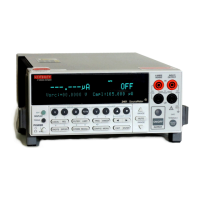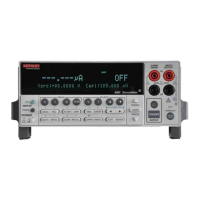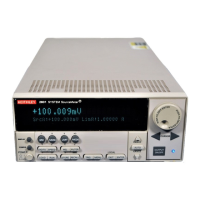2400S-903-01 Rev. E / September 2011 Return to Section Topics 1-9
Series 2400 SourceMeter® Quick Start Guide Section 1: Introduction
Figure 1-5
Cable guard connections
Ohms guard
Ohms guard allows in-circuit resistance measurements on DUT where other parasitic leakage
devices are present. Connection schemes for a Delta DUT configuration is shown in Figure 6.
NOTE Ohms guard cannot be used for high current (>100mA) ranges.
Ohms guard cannot be selected if already on a high current range.
Conversely, if ohms guard is already selected, a high current range
cannot be selected.
The following menu sequence selects ohms guard:
Press CONFIG > press MEAS Ω (or SOURCE V or SOURC
E I) > select GUARD > select OHMS
Basic connections for ohms guard is shown in Figure 6A. With V, Ω Guard and In/Out HI at virtually
the same potential,
the voltage drop across R will be 0V, and therefore, the current through R will
be 0A. Virtually all the current from In/Out HI will flow through the DUT resulting in an accurate
measurement.
If the guard resistance path (R
G
) is <1kΩ, IR drop in the V, Ω Guard test lead could be high enough
such that a significant voltage drop appears across R. The resultant leakage current through R will
corrupt the measurement of the DUT.
Guard Sense is used to cancel the effect of IR drop in the V, Ω Guard test lead as shown in Figure
6B. Guard Sense regulates the guard voltage to ensure that the same potential appears on either
side of R.
For DUT <1kΩ, 4-wire sensing should be used as shown in Figure 6C.
INPUT/
OUTPUT
4-WIRE
SENSE
HI
LO
IEEE-488
(ENTER IEEE ADDRESS
WITH FRONT PANEL MENU)
V, Ω
GUARD
GUARD
SENSE

